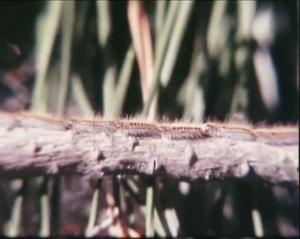
El documental muestra el ciclo vital de la oruga procesionaria del pino (Thaumetopoea Pityocampa), abundante en bosques de pinos de Europa del Sur y América del Sur y considerada como el insecto defoliador más importante de los pinares españoles.
The documentary shows the life cycle of the pine processionary caterpillar (Thaumetopoea Pityocampa), abundant in Southern European and South American forests, considered as the most important defoliating insect of the Spanish pine forests.
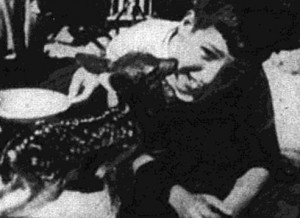
"Eye to Eye, by Tullio Pellegrini, is an instructive and hilarious romp through the insect world, as seen via extension tubes and as scenarized with a sharply satiric sense of humor. Mr. Pellegrini has managed to poke just the right amount of fun at both insects and insect hunters (particularly movie makers) to tickle the most crusty rib in the audience. Among the more madcap moments are a parody of Dragnet, in which a spider lures his hapless victims to their deaths, and a sequence of "Bug-o-Phony" sound, in which (audio-wise) caterpillars make like locomotives and ladybugs like taxicabs" PSA Journal, Jan 1955, 48.
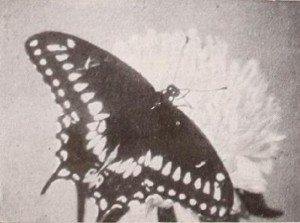
"Butterflies are John Larson's subject in this carefully planned and filmed record of the life cycle of the lepidoptera which are the Frail Children of the Sun. We are shown the beauty of the highly colored flower visitors and their varied and geometrically startling decorativeness, in footage of comforable length which fixes our interest on the movie's main topic. This is then elaborated in sequences that are not only excellently recorded in Kodachrome, but that give real information about the brief but eventful existence of the butterfly through its various incarnations. The film ends with more footage of the beauty of the summer and of the butterflies that add to that beauty." Movie Makers, Dec. 1943, 477-478.
"Garden Closeups, by W. T. McCarthy, ACL, demonstrates its right to be placed among the ten best films because of the painstaking care and time expended in its preparation and because of the exceptional results achieved. The film covers a subject which is almost entirely in miniature, but which, in its motion picture interpretation, reveals a whole new world which only the eye of a discriminating filmer and a nature lover could catch. Here are excellent closeups of the common varieties of garden flower, pictured so skillfully that the technique used is forgotten and the actual, living flower seems revealed on the screen, sometimes swaying gently in the breeze, sometimes rifled by a gigantic bumblebee pictured in alarming closeup. Another sequence will show the honeycombed intricacies of a wasp's nest, a time condensation technique showing its gradual cessation of activity as the winter comes on. An outstanding achievement in closeup technique showed the praying mantis in the very unprayerful act of devouring its victim. The film was made almost entirely with the aid of a telephoto lens with special extension, which enabled the patient cameraman to capture his flower and insect subjects from a moderate distance. Focus and exposure alike show the result of painstaking care in Garden Closeups." Movie Makers, Dec. 1932, 560.
"A story of an orange grower's everyday life, of his unending battle with pests." American Cinematographer, Nov. 1940, 498.
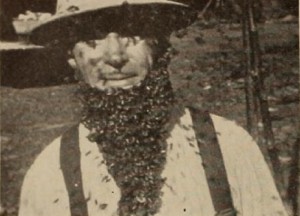
"Out of his personal experience, C. H. Bacon has produced an intimately documented film study of honey bees, both from the viewpoint of the keeper and that of the bees. Included are some extraordinary detail shots of life within the hive — the birth, life and death of a queen bee, construction of a hive, protection against natural enemies and the production of honey. Happy touches of light humor balance the more serious aspects of the subject, while the bear sequence at the end provides an amusing climax. Exceptionally well lighted and capably photographed, the picture provides entertaining and instructive screen fare." Movie Makers, Dec. 1949, 469-470.
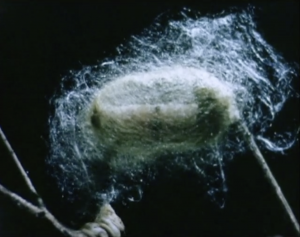
Documental sobre la metamorfosis del gusano de seda desde su nacimiento hasta su muerte, pasando por todos los procesos morfológicos.
A documentary about the silk worm metamorphosis, from its birth to its death, showing al morphologic processes.
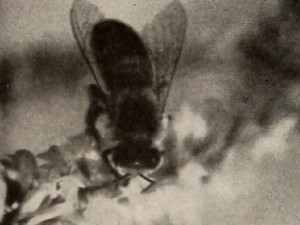
"If you have never thought much about the communal effort that produces your breakfast honey, you will find a whole new world of careful organization set forth in William W. Vincent, jr.'s movie. If you have read about this world, you will realize the very great accomplishment of the filmer of Honey Harvest, as you see his picturization of the regimented and incredibly organized bee communities. By means of amazing closeups, Mr. Vincent identifies the various workers, shows them at their hard tasks and lets us see the queen bee, the drones, the nectar scouts, the farmers, the nurses and all the complex bee classes. Nectar is sipped and collected; it is used or stored until, finally, man takes the residual product for his own use. A breakfast sequence of great compositional charm begins and ends this highly unusual record." Movie Makers, Dec. 1945, 494.
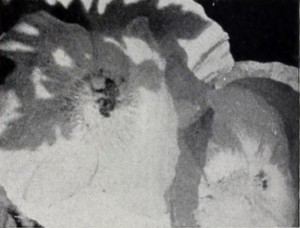
"As an openly avowed disciple of Herman Bartel, one of the old masters of nature filming, Martin E. Drayson has been an ably and imaginative pupil. Seldom have individual scenes of such delicate beauty as his poured across the screen of personal movies. Interlude in Sunlight, like Mr. Bartel's work in Awakening or Pathetique, is essentially an effort to interpret, in cinematic imagery, compositions of music. As such, it is divided into three sections or movements, comprised pictorially of bees, flowing water and flowers. The musical scores which these interpret are Paganini's Moto Perpetuo, Massenet's Meditation from Thais, and Johann Strauss's Wiener Blut waltzes. Preceding these pieces (during the lead title assembly) and between the several sections, Mr. Drayson has elected the use of complete silence." Movie Makers, Dec. 1945, 496.
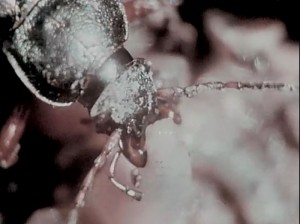
"Some of the most beautiful insects of France. Coleoptera (beetles, beetles, longhorn beetles, etc.). Lepidoptera: eggs, caterpillars, pupae, accelerated birth (zygène), slow flights (papilio, zygène, sphinx, etc.). Parasitic and predatory insects: braconid, pentatomide, ammophile, mantis." rough english translation of a description provided by Canal-U.
Total Pages: 5